
The Digital World Demands More Than Static Images
We’re in a world of short attention spans and an increasing need for instant gratification. Digital platforms are reflecting that through shorter content that blurs the line between video and static imagery.
Moving images are taking over.
The average consumer is exposed to over 10,000 messages from businesses every day. Moving images like GIFs will help your message generate 7x moreviews and engagements than a video. Brands need to create captivating content for their viewers that is going to stand out above typical videos or static images.
The World of Instant Gratification
Why are moving images capturing a user’s attention more than other visual content? It has a lot to do with consumers needing to be satisfied immediately. A 2015 study discovered that, on average, humans have a shorter attention span than goldfish. The decreasing attention span can be attributed to mobile usage, but the seemingly endless amount of on-demand entertainment options should also be taken into consideration.
With so many channels to choose from, consumers expect to be entertained or educated; if they aren’t, they’ll simply find something else that will. Digital content requires very little patience. Google calls it the micro-moment — consumers decide instantly what content to prioritize. They search for instant gratification simply because they have enough options to do so. That’s where GIFs, Boomerangs, and cinemagraphs come in. They provide more of a story than a static image, catch a user’s attention while their scrolling, and satisfy the need for quick content.
GIF
A Graphics Interchange Format(better known as GIF), is a silent looped animation with a slower transfer time than a regular video. They also commonly take the form of stop motion animation, where a series of still images play sequentially to resemble a video. GIFs are great to use for social content because of their simplicity and ease of consumption for viewers.
There are 2 billion GIFs shared every day by 300 million people globally.

As most major social media channels have integrated GIF features, you can use this form of communication almost anywhere on the internet. GIFs can be used by businesses for informal content but are also popular for consumers who use them to amplify their message, share jokes with friends, and react in the comment sections.
GIFs are better than images, but cheaper than video.
The small amount of movement makes a GIF stand out among stagnant images in a news feed. They are able to tell a short story without requiring the time commitment of creating a full video — saving you money and time. GIFs prompt a reaction in the viewer that sometimes can’t be expressed through words or even emojis.
If you’re interested in incorporating GIFs into your content, there are millions of pre-made GIFs to choose from — or you can create your own. Giphy is a great platform to search for existing GIFs and they also have an easy-to-use GIF creator.
When to use
GIFs are mobile-friendly, making them perfect to use on social media channels. They work especially great on Facebook and Instagram because of the Giphy app feature integrated into the keyboard. You can use GIFs to inject your brand’s personality and have some fun on social media!
Using GIFs from movies or other pop culture references is common.
Their use is not limited to social media — GIFs are also a great way to spice up informal emails and blog posts. You don’t have to use GIFs strictly for comedy; they’re also helpful when used to replace a how-to video.

Converse recruited Millie Bobby Brown, of Stranger Things fame, to be the face of their 2017 back-to-school campaign. They created dozens of GIFs and uploaded them to Giphy for users to share. The ‘First Day Feels’ campaign used GIFs to express the different emotions kids could be feeling about heading back to school, all while also using a relevant spokesperson that would resonate with the target audience.

Boomerang
Boomerang is an app created by Instagram, which takes a burst of photos and creates sped up, forward and backward animation. The Boomerang plays in a loop — similar to a GIF.
Boomerangs are easiest to use on Instagram because it was created by them, but it can be used on any platform that supports video. They are easy to create and don’t require a large time commitment. It’s a great way inject a fun energy into your social media and are a great opportunity to be creative in a simple way.
Timberland used a Boomerang on their Instagram in a fun energetic way to promote a new product — without being too in-your-face. The post featured the brand’s new athletic shoe — with the Boomerang of a model spinning showcasing the flexibility of the sneaker.
View this post on InstagramCan’t stop, won’t stop with kicks #MadeToFlex. Take your #Timberland Altimeters for a spin.
Cinemagraph
A cinemagraph is a “living image” that animates a single element of a photo and plays it on a loop, while keeping the rest of the image static. Cinemagraphs are more captivating than a GIF or Boomerang because it looks like an illusion.
Cinemagraphs have a thumb-stop effect — creating enough interest to make users stop scrolling.
Netflix used a cinemagraph to promote the second season of Stranger Things on Instagram. They included a lot more movement than a typical cinemagraph and also added music — showing the creative potential of the animation.
View this post on InstagramNothing was ever going back to normal. @StrangerThingsTV season 2. October 27.
Flixel or Cinemagraph Pro are easy to use apps for creating cinemagraphs. If you’re comfortable using Photoshop, check out this how-to video.
Movement is the future of digital content. GIFs, Boomerangs, and cinemagraphs are simple approaches to make your social content more engaging, spice up your newsletter, or show off your brand’s personality.
